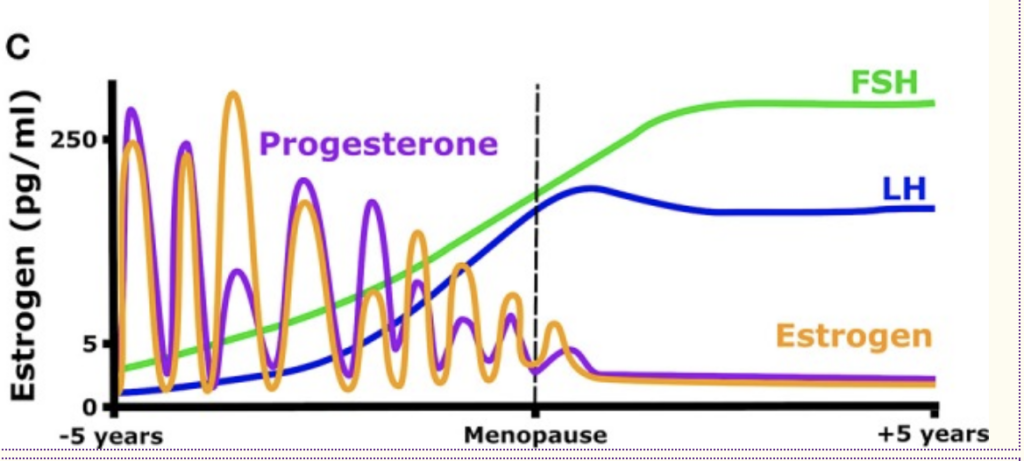In this article (clickable table of contents):
- Your cycle as an advantage
- Part 1: Your cycling years
- Tracking your cycle
- The follicular phase
- Ovulation
- The luteal phase
- Menstruation
- Putting it all together for you
- Considerations for those using an oral contraceptive pill
- Part 2: Perimenopause
- Part 3: Post-Menopause
- Additional nutrition considerations for all life stages
- Recommended follow up reading
Your cycle as an advantage

If you’ve reached the life stage where your period has slowed down (perimenopause) or stopped (post-menopause), you’re likely also noticing changes in your energy, drive and body composition. The things you used to do may not feel like they’re working the same anymore.
All of these changes, including the cyclical nature of our energy when we’re still having regular periods, are related to the interplay of key hormones – notably estrogen and progesterone, and their impact on every cell in our body.
When comparing ourselves to our male counterparts, we often take for granted that we ought to be able to perform “the same” all month long, or “the same” after menopause. This can lead to feelings of inadequacy or shame when we feel tired, are bleeding, are gaining unexpected body fat, are losing muscle, or are in other ways impacted by the changes our hormones go through.
We deserve the opportunity to learn about how our bodies work so we can harness their unique advantages, and start seeing them as something to navigate – not something to fear. When I learned how all this works, it was a joy to begin to practice and I felt the impacts quickly.
Part 1: Your reproductive years
Let’s start by understanding how our natural cycle looks, and considering the length of each of your phases.
In the diagram below a “textbook” menstrual cycle of 28 days is represented. While it is helpful to see the phases broken out, keep in mind that the length of women’s menstrual cycles and the phases it contains actually varies. For instance, you may have a 3 day period, or a 5 day period (bleed). You may ovulate on day 12 or on day 15, which changes the length of your follicular phase. Some women have a longer cycle of 35-40 days total, while others have a cycle as short as 21 days. Both ends of the spectrum and everything in between are considered normal.
The Menstrual Cycle
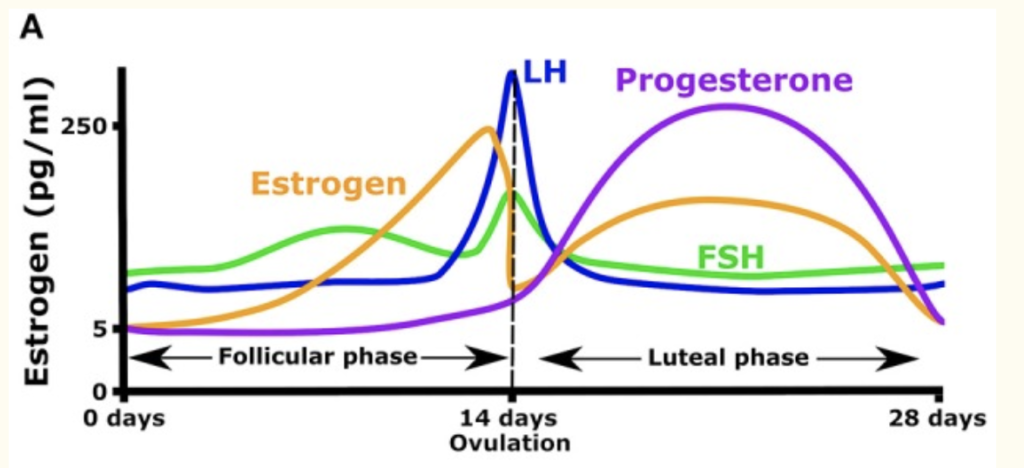
Tracking your cycle (optional)
Knowing when you ovulate and knowing when you menstruate will help you determine the type of training that will benefit you the most during each phase of your cycle, and determine the length of each phase. This is why you shouldn’t blanket apply a “4-week” or “28 day” training cycle to yourself if your menstrual cycle isn’t 28 days long.
Track the length of your entire cycle – from when your period starts to when your next period begins (helpful to do monthly)
- Track ovulation, either by getting body temperature readings from a device like one of these, or using a urine analysis tracker like Clearblue, Pregmate, or other. Another way to see your basal body temperature over the course of the entire month and know when you ovulate can be read from the Oura ring (which is what I use currently).
Knowing when your period starts and when you ovulate tells you when you’re in the follicular phase of your cycle. Knowing when you ovulate til when your period begins again tells you when you’re in the luteal phase of your cycle.
Knowing which phase you’re in can help you start using this information to optimize your nutrition and training.
Menstruation through Ovulation: the Follicular phase
The follicular phase is from the start of your period until ovulation. Estrogen rises, and is higher than progesterone. Because of this, you’re at an advantageous time to build muscle. Estrogen is “anabolic” meaning it helps increase lean mass. Progesterone increases protein breakdown, so take advantage of this first half of your cycle.
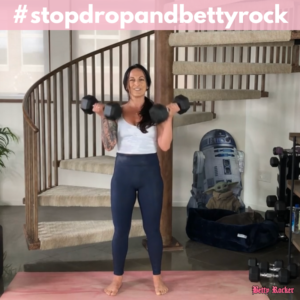
This is assuming you are eating enough to support your training, prioritizing your sleep, and not allowing stress to overwhelm you. Be sure you’re paying attention to your protein intake, and eating plenty of whole foods. Get to bed on time, and prioritize your recovery so you can knock your workouts out of the park.
If you’re taking a Betty Rocker challenge or program, this is the phase of your cycle to give it your all. Try moves you haven’t been able to do before.
You should still take rest days, but you’ll be able to recover more quickly from your workouts and your estrogen levels will support you in building more muscle during this phase.
Progressively up your resistance. Go hard, and go longer if you have time by adding an additional round to the workout, or even repeating the entire workout if it’s shorter and you still have energy.
During this phase of your cycle, you can really go for it with endurance, strength and power-type workouts. That could be high intensity interval training (HIIT), resistance training, or any type of more challenging, high-volume activity.
Ovulation
FSH (follicle stimulating hormone) and LH (luteinizing hormone) peak, causing the release of an egg from the ovary. Just prior to ovulation estrogen peaks then drops off. Progesterone begins to rise (see diagram above).
Training: During the short ovulation window, you can generally continue to go hard in your training (unless your energy feels low for any reason). Similar to the follicular phase, you can continue to do endurance or strength and power type workouts. That could be high intensity interval training, resistance training, or any type of more challenging activity. If you experience an energy drop however, listen to your body and back off on intensity.
Ovulation through Menstruation: the Luteal phase
The luteal phase occurs after ovulation. The egg travels down the fallopian tube towards the uterus, where it will attach to the uterine lining and may be fertilized. At this time, we begin to experience a greater inflammatory response, as the body is spending a lot of energy preparing for possible pregnancy, thickening the uterine lining and doing other tasks.
Progesterone is increasingly heightened, and is now the dominant player in relation to estrogen, increasing our respiration rate and our core temperature as much as 0.5 C. This can impact sleep – as in it becomes harder in the second half of your cycle to get that good, deep sleep. You’ll also have a greater need for amino acids during this time, so it’s a great time to intentionally up your protein intake.

You can taper your training down in intensity during this phase as you begin to notice tiredness or less drive. Some options I recommend:
- do half or part of your regularly scheduled workout
- use less resistance than you expected you would
- begin the workout at your normal resistance volume, but taper it off in subsequent rounds
- take low impact versions of higher impact moves.
Simply having the mindset that the body is shifting has been tremendously helpful to many women – knowing that they don’t have to have the same expectation of their output in the luteal phase helps people give themselves permission to shift more easily into training adaptations that feel good to the body.
In the latter part of the luteal phase (days 5-7 or so before your period depending on your cycle length), you may feel a little more fatigued, due to estrogen and progesterone crossing to the brain and effecting the central nervous system. It’s a great time to really lower the resistance (weight) and intensity of your cardio, focus on technique drills, and swap in more mobility and functional movement skills classes.
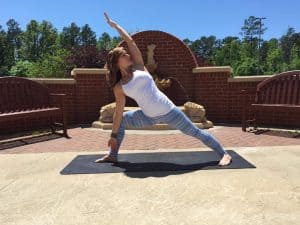
Listen to your body and adapt your plan for the day if your energy is dropping off. It is not beneficial to push yourself extra hard when you feel this way, especially if it corresponds to that heightened inflammatory response that happens in that second half of the menstrual cycle.
Menstruation
While this is technically at the start of your cycle and included in the follicular phase, I’ve listed it last as it makes a bit more sense once you understand all the other stages of your cycle.

Take a look at the diagram above, which I’ve repeated here so you don’t have to scroll up. Menstruation is happening just at the beginning of this chart, days 0-3,4,5 or however many days you bleed for. At the end of the cycle map above, you can see progesterone dropping off at the end of the luteal phase where the tissues lining the uterus break down and shed from the body.
You may have less energy during your bleeding time than after it stops, but many women begin to feel more energized as progesterone drops down, bringing their core temperature back to normal, and estrogen once again takes a front seat as the follicular phase progresses again. Your period can be a transitionary phase, and you may shift through feeling low energy to higher energy over the course of your period, as your body starts to experience the effects of the follicular phase again.
Training: This is really up to you. If you feel tired, do more gentle movement and things that feel restorative throughout menstruation – similar to what you were doing leading up to it. It can be really helpful to get moving if you can, and going for a walk or hike or bike ride to stimulate your circulation and energy levels. But listen to your body, and stay hydrated. If you begin to feel energized and strong, you can begin training at a volume that suits you, like we talked about with the follicular phase.
Putting it together for you
To make it super easy for you, here is an example training schedule for someone with a textbook 28-day menstrual cycle (apply the phases to your own):
Day 1-14 (follicular phase): Follow your workouts and training schedule as written. Give your workouts all you’ve got! Nourish yourself, get good sleep, don’t skip your rest days and be mindful of your stress levels.
Day 14 (ovulation) Keep the status quo.
Day 15-21 (luteal phase beginning): Keep tabs on your energy levels and pace yourself in your workouts to match how much energy you have. You might not notice much change during the first week of your luteal phase, but everyone is different. Start to really pay attention to your protein intake and make sure you’re getting enough consistently along with your other whole food meals.
Day 22-28 (luteal phase – end): You may start to feel more tired more easily, so give yourself permission to shorten your workouts, make them lower impact, or replace them with more yoga, stretching or low impact activities. You can take extra rest days as well leading up to your period with no impact on your training results when you are also paying attention to getting enough protein and eating whole food meals.
Considerations for training if you’re on the pill
There’s no question, women deserve reproductive options. I just want to present the information associated with the pill as it relates to your training goals as this is rarely, if ever really shared with women who are getting on it.
An oral contraceptive pill will modify your body’s natural estrogen and progesterone cycling by delivering a low dose of hormones on a daily basis. This suppresses your natural cycle and hormones. The week that you are on the sugar pill is the week your body bleeds, but it is not the same as regular menstruation. Below is a diagram of what your hormones are doing when you’re on the pill:
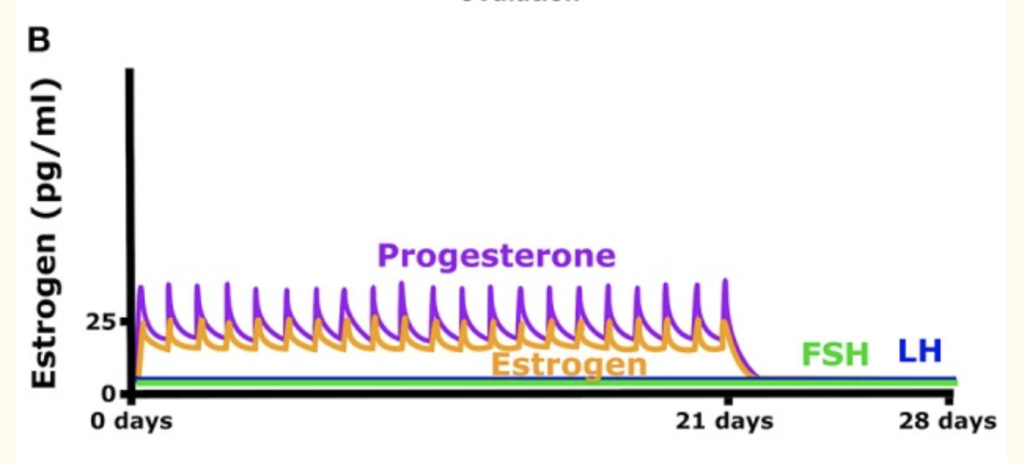
Training: Because of the variation from what your body would do naturally you can still “periodize” your training by doing more high-volume training in the first 3 weeks, and backing off during the sugar pill week that you bleed.
There is evidence that the pill impacts our ability to build muscle, and can impact the strength we’re able to gain from our training (meaning we may increase size, but not actual strength). There is also evidence that women on the pill may experience increased oxidative stress, and are associated with fat gain and fluid retention. This makes sense when we consider the advantages the first half of our cycles give us for building muscle when we have more estrogen circulating – if that is being suppressed by the pill we can’t take advantage of it the same way.
I’ve discussed the pill in some depth with Dr. Jolene Brighten on my podcast previously who makes the point that women deserve to know the ramifications and long term effects of being on the pill, and that many women are put on the pill by their doctor to cover up or deal with other issues they’re having – without ever getting to the root cause of these issues. Feel free to listen to that episode for much more on this subject from a doctor I trust, and to hear my own experience with taking the pill for almost 14 years.
Part 2: Training in Perimenopause: (click here for the complete training and nutrition guide)
In perimenopause – the 5 or so years leading up to menopause, our cycles start to become more erratic, and things that used to work for you might not be working anymore because you don’t have the same regular fluctuation of estrogen and progesterone.
ABOVE: in the illustration above, we see how the perimenopause cycle looks as compared to what happens after menopause. The orange and purple lines represent the varying and erratic lengths of a woman’s cycle and fluctuating levels of estrogen and progesterone.
A lot of women start experiencing more weight gain during this time in their lives. This is usually concurrent with a loss of muscle and bone density, both things we want to avoid. Focusing on muscular strength at this time will actually help with fat loss!
Worried muscle will make you bulky? Don’t be! Muscle tissue is more compact and dense than fat tissue.
Five pounds of muscle takes up much less space than five pounds of fat, so as you lose fat and add muscle, your body will look physically smaller – though your weight may not change as much as you think. Interested in more about how this works? Listen to this 10 minute podcast where I explain the “Truth about your weight!“
The common mistake I see women making at this time is training more and eating less. This contributes to more inflammation in your body as the body tries to keep up with the repair from your workouts with less fuel – causing more muscle breakdown and more fat storage.
The increased stress to your system can also spike your cortisol, which also has the effect of increasing fat storage and breaking down muscle.
The best kind of training for us at this time in our lives include resistance training and HIIT (high intensity intervals) or any kind of sprint or fast burst/explosive cardio. All of my training programs are ideal as they pairs these training types, so you’re in the right place!
This is a stage of life when we want to be hitting those high intensities, both with “high intensity interval training” (HIIT), and ramping up the resistance training to add more load to the body.
Because we no longer have the same amounts of fluctuating estrogen and progesterone to drive lean mass development, we need to increase the training stimulus in other ways. Both of these types of higher volume training drive adaptations that will enable us to maintain and build lean mass. You want to meet yourself where you’re at with this, and don’t force yourself to go to hard too fast.
The other piece to keep in mind is that strategically timed recovery days are more important than ever, so your body can recover effectively and lower the natural inflammatory response that we get from a tough workout.
To get the muscle stimulus, you want to challenge yourself effectively when you train. That means you come to your workouts rested and ready to work – and if you’re still recovering from your last session and your system is still in repair mode, you won’t be able to burn fat or build muscle.
Taking strategic recovery sets you up for greater effort and greater restoration periods between workouts to better stimulate muscle protein synthesis as hormones begin to become slightly erratic.
This means rather than going hard 5 or 6 days a week in a row, you actually start to stagger your tough workouts with recovery days.
The way I suggest you approach this is to play around with a 3 day or 4 day workout week. Both are highly effective and I suggest following the one that works best for your schedule, energy, and intensity of your training days. I have optimized every Betty Rocker training program, and created custom tracks in every challenge in Rock Your Life so you can follow the best path for you!
4 Day split:
- M- workout
- Tu – workout
- W – REST
- Th – workout
- F- workout
- Sa – REST
- Su – mobility, yoga or other self care activity
3 Day split:
- M – workout
- Tu – REST
- W – workout
- Th – REST
- F- workout
- Sa – REST
- Su – Mobility, Yoga or other self care activity
BOTH of these splits are highly effective for us during this life stage and into post menopause, and provide more recovery so we have more power output potential in the workouts we do – as long as we’re also fueling, sleeping and managing stress effectively.
The final piece I’ll add here for you is that to stimulate the muscle to respond, you need the building blocks of amino acids.
As we get into our 40’s, we don’t absorb the amino acids from our dietary protein as readily. So it’s imperative to increase the amount of protein you’re eating if you want to support the repair and rebuild process from your workouts.
This is beneficial to you in other ways as well – since protein is more satisfying than fat or carbs, you’ll feel more full when you eat enough protein in your meals, and have less cravings and be less prone to overeat – further helping you reach your goals.
Part 3: Training Post-Menopause: (click here for the complete training and nutrition guide)

Above we see how the cycle becomes erratic during perimenopause and hormone levels begin to dwindle as we approach menopause. In menopause, the hormones that caused the menstrual cycle flatline.
When we stop having our period, we enter the post-menopause phase. Post menopause we no longer have the monthly cycling of estrogen and progesterone, and our estrogen levels (particularly the E2, estradiol which had the biggest impact on muscle building) has dropped off.
While we no longer have the same stimulus from those circulating hormones, we can still create a highly effective muscle stimulus and see real fat loss happen when we train with an aim to challenge the muscle to respond, take the recovery we need to repair the tissue effectively, and intentionally fuel our body with the building blocks for that repair and rebuild phase.
This is the time to get strategic with your training timing to create muscular adaptations in the absence of the E2 estrogen.
Your muscles require a stimulus to adapt and build new tissue. That means if you’re training day after day, you’re not ever fully recovered for the workouts you do and you won’t be able to hit your workouts as hard to create those adaptations.
In all of my workout programs, you have a combination of the two most effective training tactics to stimulate your tissue to respond: resistance training and explosive cardio.
Resistance training and explosive cardio and the level of challenge they bring your body are both subjective to where you are in your fitness journey. It doesn’t matter “how much” resistance you start with – it only matters that you are workout against a load that you feel challenged by.
Over time, you’ll build strength because the muscles will adapt to the load you give your body. With explosive cardio, you’re getting your heart rate up and challenging yourself within your limits. You’ll only get stronger as you go, so avoid comparison and focus on yourself and listening to your body.
This “ramping up” and doing “hard” workouts is a gradual process to accomplish, as we want to build strength safely and begin where we’re currently at, not injure ourselves overdoing it too fast.
Remember that a workout creates an inflammatory response and breaks down muscle tissue. Without recovery and the right fuel, we can’t rebuild it. This means no more “no days off” training schedules.
The way I suggest you approach this is to play around with a 3 day or 4 day workout week. I would sequence my training in one of two ways (depending on what works best for your schedule, energy, and intensity of your training days). II have optimized every Betty Rocker training program, and created custom tracks in every challenge in Rock Your Life so you can follow the best path for you!
4 Day split:
- M- workout
- Tu – workout
- W – REST
- Th – workout
- F- workout
- Sa – REST
- Su – mobility, yoga or other self care activity
3 Day split:
- M – workout
- Tu – REST
- W – workout
- Th – REST
- F- workout
- Sa – REST
- Su – Mobility, Yoga or other self care activity
BOTH of these splits are highly effective for us during this life stage and provide more recovery so we have more power output potential in the workouts we do – as long as we’re also fueling, sleeping and managing stress effectively.
The things you surround our workouts with, notably your protein intake are also imperative for creating the restoration of the muscle tissue. If you’re not fueling around your workouts, your body may be in a constant breakdown state and you simply can’t repair or rebuild your muscle tissue without the right nutrients.
Once we get over 40, we don’t absorb the amino acids from our dietary protein as readily, so you need more to do the same amount of work.
The amino acids from protein support muscle protein synthesis and that repair/rebuild process, but they also support cognitive function, mood, hormone and enzyme function and your immune system function. So prioritize having protein in each meal and build a balanced plate that includes fiber-rich carbs from whole food sources and healthy fat.
Additional Nutrition considerations and resources for all life stages
One of the most essential things to consider when you’re training regularly is that you are adequately fueled for your training. Going into your workouts fueled is going to allow for adaptations and energy output, and help you preserve the lean mass you have so you can build more.
Low energy availability (LEA) is a far more common occurrence in women than men, as many of us are not eating enough for our needs – whether because of the demands on our time and lack of prioritization, or because we’re intentionally cutting calories or skipping meals. Being in an underfed state causes cortisol to rise, which increases fat storage.
If you don’t have enough amino acids circulating in your system throughout the day and your body needs to use them, it breaks down your muscle tissue to access the aminos stored there. Your body needs enough amino acids for muscle protein synthesis, not to mention enzyme and hormone function, brain health and your immune system.
Remember that your body is also breaking down muscle during a workout. This is why we want to be including protein with each meal we eat, and paying attention to fueling around your workouts to optimize your body’s ability for tissue repair and muscle protein synthesis.

The essential amino acid leucine is integral to muscle protein synthesis, and ensuring that you have enough of this amino acid (along with all the essential aminos that your body cannot make on its own) will support your training goals.
Prioritize your protein intake through your entire cycle – aiming for at least 20-30 grams of protein per meal if you’re under 40, and between 30-40 grams per meal if you’re over 40.
If you’re over 40 and in perimenopause or menopause, this is essential, as you need the additional stimulus of more amino acids to be able to build muscle, especially as estrogen levels begin to wane.
I use protein powder to increase my overall daily intake of protein, like my organic I ❤️ Vanilla Protein. I’ll use it to boost the protein content of my breakfast foods, as a shake post workout, or even if I’m going to do a morning workout and need a little fuel going into it to help me access my best output.
Because I tend to perform best an hour or so after a meal, I like to work out an hour or so after breakfast, and have a protein shake with fruit afterwards. Just like the protein from whole foods, a protein powder has to break down after you ingest it for your body to access the amino acids.

In their free form, aminos do not have to be broken down, making them a great supplement to support you during your workout, and also help improve recovery. However you should not replace your protein powder or dietary protein with an amino acid supplement. I would consider that a “bonus” for workout purposes, but you still need enough dietary protein (which includes a protein powder that your body also has to break down).
This prioritization of protein is especially important in the high hormone phase (after you ovulate) as your body is in a continuous breakdown state with elevated cortisol and progesterone, breaking down more tissue. Be sure you’re adding protein to each meal, and consider using a quality protein shake to conveniently boost your daily intake.
Prioritizing quality, complex carbohydrates around your training (and quick carbs during your training for longer training sessions) is essential for both recovery and energy to push through your workouts.
Follow up reading:
I hope this article has given you a good foundation to build upon. Know that we provide a lot of guidance for all of this inside Rock Your Life, my online home workout studio and women’s fitness community where you can find training programs and challenges, recipes, a private women’s fitness community, coaching and more! Get a trial today, and join us!
Here are some articles on the blog that discuss training and nutrition through the life cycle from different angles:
How Eating the Right Amount of Protein Affects a Woman’s Body
Shifting the Muscle to Fat Ratio: Women-Specific Body Composition Considerations
6 Adaptogens that Support Hormone Balance
Eating and Training with Your Cycle (part 1) with Dr. Stacy Sims
Eating and Training with Your Cycle (part 2) with Dr. Stacy Sims
Women-Specific Nutrition and Training with Dr. Stacy Sims
